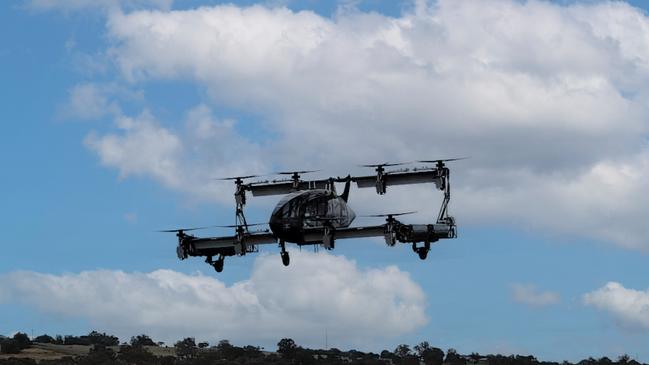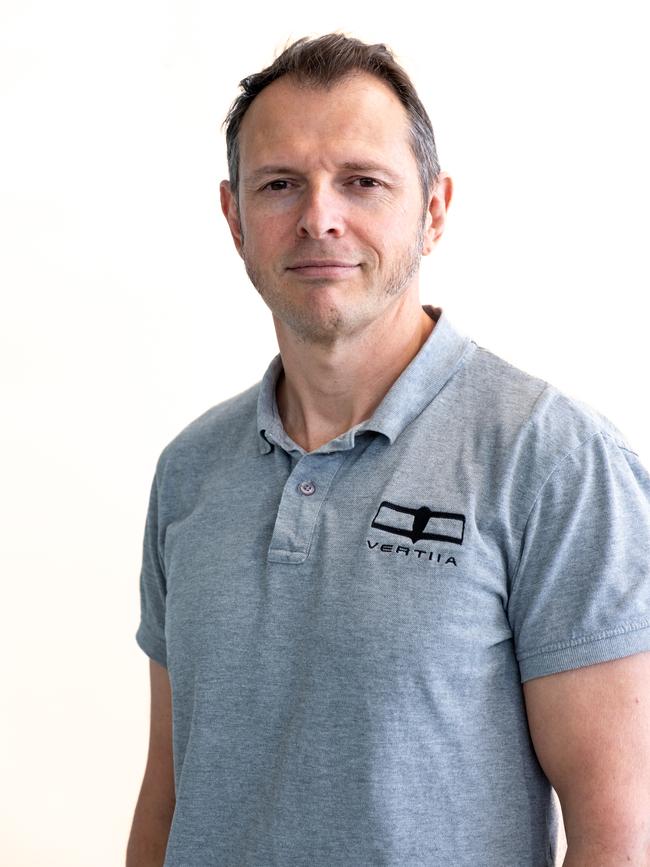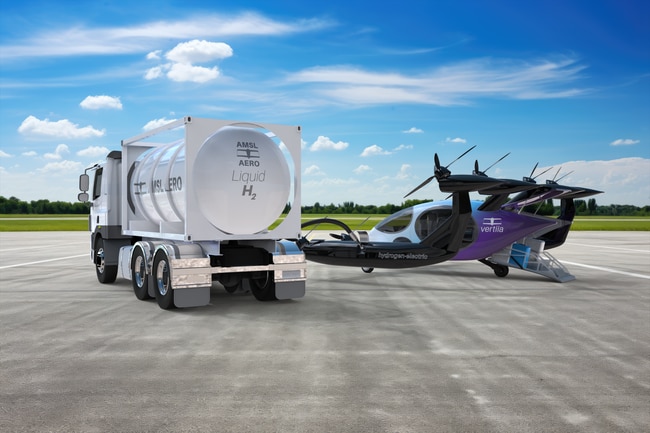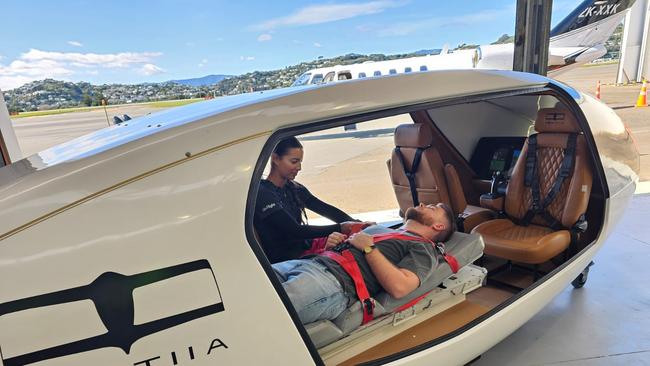Aviation start-up’s self flying, hydrogen-powered plane takes to the sky after raising $55m
As Qantas CEO Vanessa Hudson battles a pay dispute with pilots, a Sydney-based aviation start-up has a solution that could not only trim the wages bill but also make the airline greener.

If anyone knows how to get five minutes with Vanessa Hudson, Andrew Moore wants to chat.
As Qantas battles a pay dispute with its short-haul pilots, Mr Moore’s start-up AMSL Aero – backed by some of Australia’s biggest superannuation funds – may prove they’re not necessary on some flights.
The Bankstown-headquartered company has completed its first free flight of its Vertiia aircraft, which takes off like a helicopter but flies like a plane, after more than seven years in development.
Mr Moore’s eyes are on the regional market, where he believes it will not only help fly passengers but also help fight bushfires and deliver essential medical supplies – saying it could do so more safely and up to 70 per cent cheaper than a helicopter.
He has already attracted big name backers including Host Plus, Telstra Super, StB Capital Partners and IP Group Australia, raising $55m so far. Qantas is yet to join the list of investors, but Mr Moore - an ex-navy test pilot and engineer - would love a chat with Ms Hudson.
“I’d give her a call and see what she thinks,” he said.
“We’ve been raising money from day one, and I’ll be raising money for a long time yet. So I’m always looking for an opportunity to talk to investors, because it accelerates what we can do.”
AMSL Aero is developing autonomous and piloted versions of Vertiia, with plans to fly commercially in 2027.

The aircraft is powered by hydrogen, generating zero emissions in a sector that’s notoriously difficult to decarbonise. The use of hydrogen is also equally notorious in aviation, with sceptics highlighting the Hindenburg disaster in 1937, which killed 32 people. But Mr Moore is quick to douse those fears.
“Back in the day, the US controlled helium and the Hindenburg was a German airship and they were not allowed to access helium. So that’s the first point,” Mr Moore said.
“The second point is in the Hindenburg disaster, nobody died from hydrogen fire. The hydrogen fire was quick and rapid. Half the people survived. Half of those lost their lives jumping from the aircraft and the other half suffered burns from the bituminous paint that was used to paint the airship.
“As a consequence of that accident, the safety impacts of hydrogen somewhat misrepresents the facts.”
Whereas, Mr Moore said light aircraft still used leaded fuels. “I don’t think anybody has found a health benefit of lead in any way, shape or form but it’s still used across aircraft across the world today.
“And I couldn’t think of a better way to spread brain altering toxins, than flying above people’s heads. Similarly, if you look at the hazards of petrol and diesel fuels, it doesn’t take long to find evidence of a fire.”
In January, five people were killed when a Japan Airlines jet – carrying hundreds of passengers – burst into flames after colliding with an earthquake relief plan at Tokyo’s Haneda airport.
“When you rupture a fuel tank on a conventional aircraft, it typically spills and pools around the bottom of that aircraft and then incinerates it and anything that’s left inside it. So actually, I’m looking forward to the safety benefits that come with hydrogen because it is far safer and has lower toxicity than the fuels that we’ve come to accept,” Mr Moore said, adding that hydrogen fuel cells helped man land on the moon.

AMSL Aero’s Vertiia aircraft is designed to fly up to 1000 kilometres, with a cruising speed of 300km/h an hour, carrying up to four people – although Mr Moore said they could build bigger planes.
Mr Moore said the 1000km range “opens up all the existing markets that use aviation today” rather than battery-powered only aircraft, which are restricted to short tourism flights.
“They talk about the golden triangle in Australia – Sydney to Canberra is 250km, Sydney to Melbourne is 750km and Sydney to Brisbane is about the same – so if you can get 1000 you serve one of the busiest routes and most profitable routes in the world.”
This year, AMSL Aero received deposits for 26 Vertiia aircraft orders from civil customers including 20 from Aviation Logistics, which operates the Air Link, AirMed and Chartair brands covering passenger services, aircraft charter, air freight and aeromedical flights across Australia.
In comes as the eVTOL (electric vertical take-off and landing) begins to cool. German start-up Lilium raised about €1.4 billion from private investors but went bust last month.
Uber also announced local flying taxi trials, which were later abandoned after the ride sharing giant sold its air division to Joby Aviation four years ago.

Elsewhere, Amazon’s drone program – headed by Australian David Carbon, and also involves aircraft taking off vertically and flying horizontally – is edging closer to regulatory approval, with trials scheduled for Italy and the UK. And Mr Moore said his start-up will help the Seattle-based tech titan.
“Any time someone gets approval for the first time, that makes it easier for someone to follow in their footsteps,” Mr Moore said.
“So the work that companies are doing on smaller drones does have an impact, does push the needle in the right direction from our standpoint. But we are the first to in Australia to fly a large remote piloted eVTOL aircraft under CASA (Civil Aviation Safety Authority) rules and so we have shifted the needle for everyone else.
“The approvals we have, if they are not the most complex CASA has worked through in this country, they are certainly one of the most complex, and so the magnitude of what we’ve done has made it easier for Amazon to operate (drones) in Australia”.



